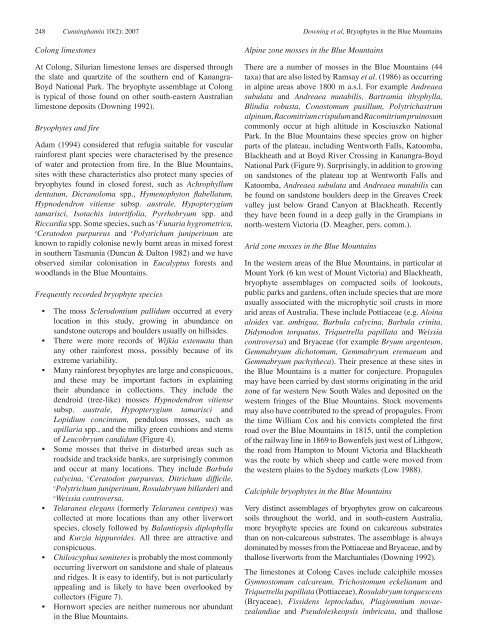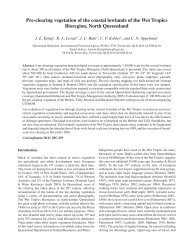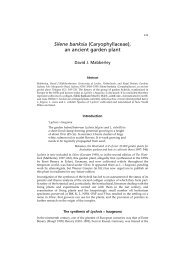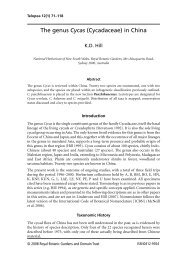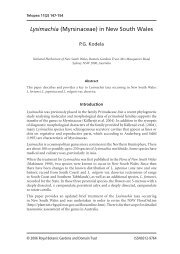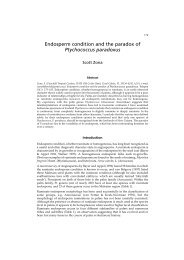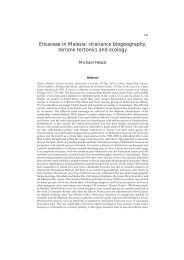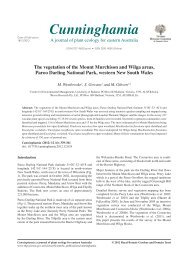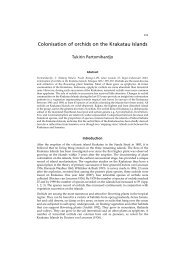Bryophytes and their distribution in the Blue Mountains region of ...
Bryophytes and their distribution in the Blue Mountains region of ...
Bryophytes and their distribution in the Blue Mountains region of ...
You also want an ePaper? Increase the reach of your titles
YUMPU automatically turns print PDFs into web optimized ePapers that Google loves.
248 Cunn<strong>in</strong>ghamia 10(2): 2007 Down<strong>in</strong>g et al, <strong>Bryophytes</strong> <strong>in</strong> <strong>the</strong> <strong>Blue</strong> Mounta<strong>in</strong>s<br />
Colong limestones<br />
At Colong, Silurian limestone lenses are dispersed through<br />
<strong>the</strong> slate <strong>and</strong> quartzite <strong>of</strong> <strong>the</strong> sou<strong>the</strong>rn end <strong>of</strong> Kanangra-<br />
Boyd National Park. The bryophyte assemblage at Colong<br />
is typical <strong>of</strong> those found on o<strong>the</strong>r south-eastern Australian<br />
limestone deposits (Down<strong>in</strong>g 1992).<br />
<strong>Bryophytes</strong> <strong>and</strong> fire<br />
Adam (1994) considered that refugia suitable for vascular<br />
ra<strong>in</strong>forest plant species were characterised by <strong>the</strong> presence<br />
<strong>of</strong> water <strong>and</strong> protection from fire. In <strong>the</strong> <strong>Blue</strong> Mounta<strong>in</strong>s,<br />
sites with <strong>the</strong>se characteristics also protect many species <strong>of</strong><br />
bryophytes found <strong>in</strong> closed forest, such as Achrophyllum<br />
dentatum, Dicranoloma spp., Hymenophyton flabellatum,<br />
Hypnodendron vitiense subsp. australe, Hypopterygium<br />
tamarisci, Isotachis <strong>in</strong>tortifolia, Pyrrhobryum spp. <strong>and</strong><br />
Riccardia spp. Some species, such as c Funaria hygrometrica,<br />
c Ceratodon purpureus <strong>and</strong> c Polytrichum juniper<strong>in</strong>um are<br />
known to rapidly colonise newly burnt areas <strong>in</strong> mixed forest<br />
<strong>in</strong> sou<strong>the</strong>rn Tasmania (Duncan & Dalton 1982) <strong>and</strong> we have<br />
observed similar colonisation <strong>in</strong> Eucalyptus forests <strong>and</strong><br />
woodl<strong>and</strong>s <strong>in</strong> <strong>the</strong> <strong>Blue</strong> Mounta<strong>in</strong>s.<br />
Frequently recorded bryophyte species<br />
• The moss Sclerodontium pallidum occurred at every<br />
location <strong>in</strong> this study, grow<strong>in</strong>g <strong>in</strong> abundance on<br />
s<strong>and</strong>stone outcrops <strong>and</strong> boulders usually on hillsides.<br />
• There were more records <strong>of</strong> Wijkia extenuata than<br />
any o<strong>the</strong>r ra<strong>in</strong>forest moss, possibly because <strong>of</strong> its<br />
extreme variability.<br />
• Many ra<strong>in</strong>forest bryophytes are large <strong>and</strong> conspicuous,<br />
<strong>and</strong> <strong>the</strong>se may be important factors <strong>in</strong> expla<strong>in</strong><strong>in</strong>g<br />
<strong><strong>the</strong>ir</strong> abundance <strong>in</strong> collections. They <strong>in</strong>clude <strong>the</strong><br />
dendroid (tree-like) mosses Hypnodendron vitiense<br />
subsp. australe, Hypopterygium tamarisci <strong>and</strong><br />
Lopidium conc<strong>in</strong>num, pendulous mosses, such as<br />
apillaria spp., <strong>and</strong> <strong>the</strong> milky green cushions <strong>and</strong> stems<br />
<strong>of</strong> Leucobryum c<strong>and</strong>idum (Figure 4).<br />
• Some mosses that thrive <strong>in</strong> disturbed areas such as<br />
roadside <strong>and</strong> trackside banks, are surpris<strong>in</strong>gly common<br />
<strong>and</strong> occur at many locations. They <strong>in</strong>clude Barbula<br />
calyc<strong>in</strong>a, c Ceratodon purpureus, Ditrichum difficile,<br />
c Polytrichum juniper<strong>in</strong>um, Rosulabryum billarderi <strong>and</strong><br />
c Weissia controversa.<br />
• Telaranea elegans (formerly Telaranea centipes) was<br />
collected at more locations than any o<strong>the</strong>r liverwort<br />
species, closely followed by Balantiopsis diplophylla<br />
<strong>and</strong> Kurzia hippuroides. All three are attractive <strong>and</strong><br />
conspicuous.<br />
• Chiloscyphus semiteres is probably <strong>the</strong> most commonly<br />
occurr<strong>in</strong>g liverwort on s<strong>and</strong>stone <strong>and</strong> shale <strong>of</strong> plateaus<br />
<strong>and</strong> ridges. It is easy to identify, but is not particularly<br />
appeal<strong>in</strong>g <strong>and</strong> is likely to have been overlooked by<br />
collectors (Figure 7).<br />
• Hornwort species are nei<strong>the</strong>r numerous nor abundant<br />
<strong>in</strong> <strong>the</strong> <strong>Blue</strong> Mounta<strong>in</strong>s.<br />
Alp<strong>in</strong>e zone mosses <strong>in</strong> <strong>the</strong> <strong>Blue</strong> Mounta<strong>in</strong>s<br />
There are a number <strong>of</strong> mosses <strong>in</strong> <strong>the</strong> <strong>Blue</strong> Mounta<strong>in</strong>s (44<br />
taxa) that are also listed by Ramsay et al. (1986) as occurr<strong>in</strong>g<br />
<strong>in</strong> alp<strong>in</strong>e areas above 1800 m a.s.l. For example Andreaea<br />
subulata <strong>and</strong> Andreaea mutabilis, Bartramia ithyphylla,<br />
Bl<strong>in</strong>dia robusta, Conostomum pusillum, Polytrichastrum<br />
alp<strong>in</strong>um, Racomitrium crispulum <strong>and</strong> Racomitrium pru<strong>in</strong>osum<br />
commonly occur at high altitude <strong>in</strong> Kosciuszko National<br />
Park. In <strong>the</strong> <strong>Blue</strong> Mounta<strong>in</strong>s <strong>the</strong>se species grow on higher<br />
parts <strong>of</strong> <strong>the</strong> plateau, <strong>in</strong>clud<strong>in</strong>g Wentworth Falls, Katoomba,<br />
Blackheath <strong>and</strong> at Boyd River Cross<strong>in</strong>g <strong>in</strong> Kanangra-Boyd<br />
National Park (Figure 9). Surpris<strong>in</strong>gly, <strong>in</strong> addition to grow<strong>in</strong>g<br />
on s<strong>and</strong>stones <strong>of</strong> <strong>the</strong> plateau top at Wentworth Falls <strong>and</strong><br />
Katoomba, Andreaea subulata <strong>and</strong> Andreaea mutabilis can<br />
be found on s<strong>and</strong>stone boulders deep <strong>in</strong> <strong>the</strong> Greaves Creek<br />
valley just below Gr<strong>and</strong> Canyon at Blackheath. Recently<br />
<strong>the</strong>y have been found <strong>in</strong> a deep gully <strong>in</strong> <strong>the</strong> Grampians <strong>in</strong><br />
north-western Victoria (D. Meagher, pers. comm.).<br />
Arid zone mosses <strong>in</strong> <strong>the</strong> <strong>Blue</strong> Mounta<strong>in</strong>s<br />
In <strong>the</strong> western areas <strong>of</strong> <strong>the</strong> <strong>Blue</strong> Mounta<strong>in</strong>s, <strong>in</strong> particular at<br />
Mount York (6 km west <strong>of</strong> Mount Victoria) <strong>and</strong> Blackheath,<br />
bryophyte assemblages on compacted soils <strong>of</strong> lookouts,<br />
public parks <strong>and</strong> gardens, <strong>of</strong>ten <strong>in</strong>clude species that are more<br />
usually associated with <strong>the</strong> microphytic soil crusts <strong>in</strong> more<br />
arid areas <strong>of</strong> Australia. These <strong>in</strong>clude Pottiaceae (e.g. Alo<strong>in</strong>a<br />
aloides var. ambigua, Barbula calyc<strong>in</strong>a, Barbula cr<strong>in</strong>ita,<br />
Didymodon torquatus, Triquetrella papillata <strong>and</strong> Weissia<br />
controversa) <strong>and</strong> Bryaceae (for example Bryum argenteum,<br />
Gemmabryum dichotomum, Gemmabryum eremaeum <strong>and</strong><br />
Gemmabryum pachy<strong>the</strong>ca). Their presence at <strong>the</strong>se sites <strong>in</strong><br />
<strong>the</strong> <strong>Blue</strong> Mounta<strong>in</strong>s is a matter for conjecture. Propagules<br />
may have been carried by dust storms orig<strong>in</strong>at<strong>in</strong>g <strong>in</strong> <strong>the</strong> arid<br />
zone <strong>of</strong> far western New South Wales <strong>and</strong> deposited on <strong>the</strong><br />
western fr<strong>in</strong>ges <strong>of</strong> <strong>the</strong> <strong>Blue</strong> Mounta<strong>in</strong>s. Stock movements<br />
may also have contributed to <strong>the</strong> spread <strong>of</strong> propagules. From<br />
<strong>the</strong> time William Cox <strong>and</strong> his convicts completed <strong>the</strong> first<br />
road over <strong>the</strong> <strong>Blue</strong> Mounta<strong>in</strong>s <strong>in</strong> 1815, until <strong>the</strong> completion<br />
<strong>of</strong> <strong>the</strong> railway l<strong>in</strong>e <strong>in</strong> 1869 to Bowenfels just west <strong>of</strong> Lithgow,<br />
<strong>the</strong> road from Hampton to Mount Victoria <strong>and</strong> Blackheath<br />
was <strong>the</strong> route by which sheep <strong>and</strong> cattle were moved from<br />
<strong>the</strong> western pla<strong>in</strong>s to <strong>the</strong> Sydney markets (Low 1988).<br />
Calciphile bryophytes <strong>in</strong> <strong>the</strong> <strong>Blue</strong> Mounta<strong>in</strong>s<br />
Very dist<strong>in</strong>ct assemblages <strong>of</strong> bryophytes grow on calcareous<br />
soils throughout <strong>the</strong> world, <strong>and</strong> <strong>in</strong> south-eastern Australia,<br />
more bryophyte species are found on calcareous substrates<br />
than on non-calcareous substrates. The assemblage is always<br />
dom<strong>in</strong>ated by mosses from <strong>the</strong> Pottiaceae <strong>and</strong> Bryaceae, <strong>and</strong> by<br />
thallose liverworts from <strong>the</strong> Marchantiales (Down<strong>in</strong>g 1992).<br />
The limestones at Colong Caves <strong>in</strong>clude calciphile mosses<br />
Gymnostomum calcareum, Trichostomum eckelianum <strong>and</strong><br />
Triquetrella papillata (Pottiaceae), Rosulabryum torquescens<br />
(Bryaceae), Fissidens leptocladus, Plagiomnium novaezeal<strong>and</strong>iae<br />
<strong>and</strong> Pseudoleskeopsis imbricata, <strong>and</strong> thallose


